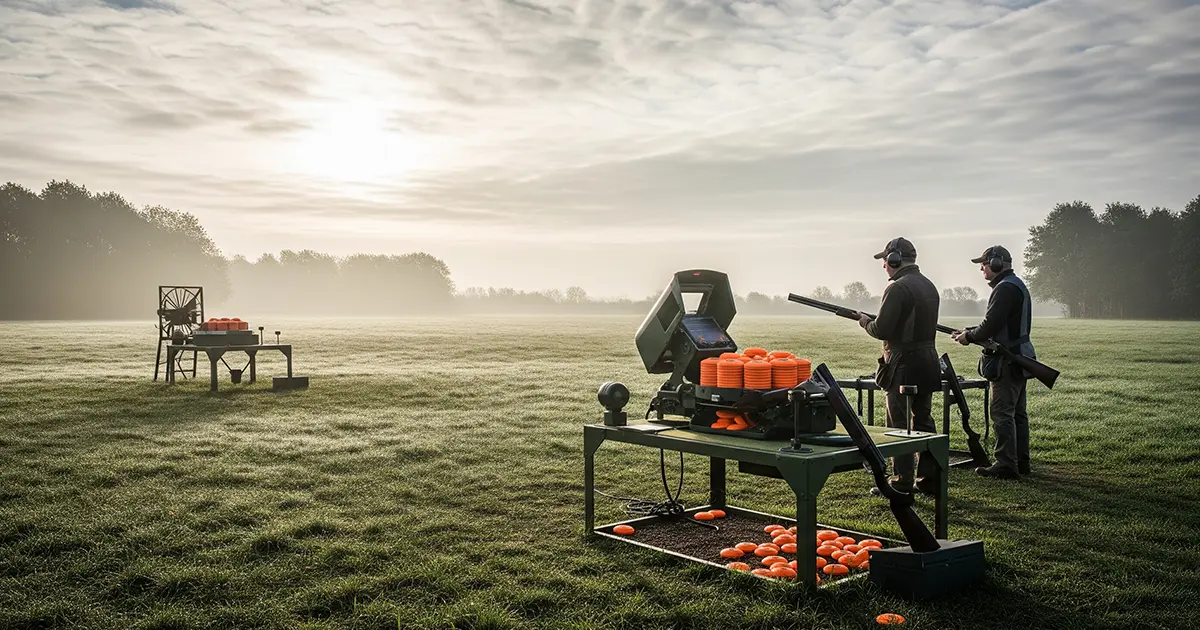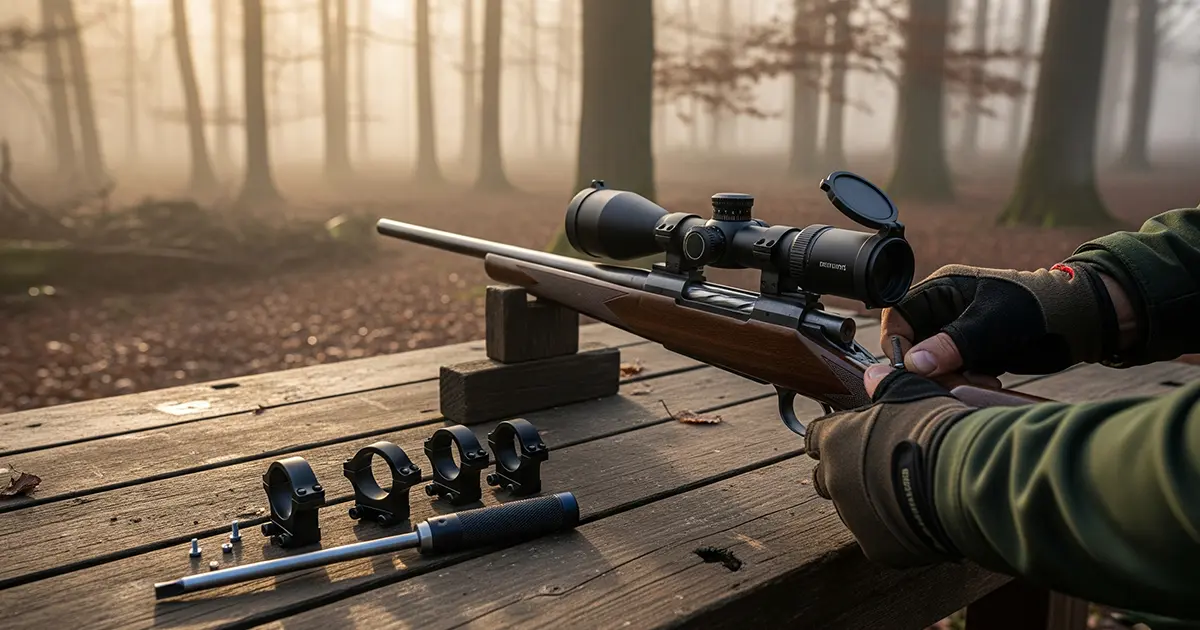Clay traps are the engine room of any good session, whether you are practising on the farm or running a busy Sunday at the club. This guide explains the practical differences between manual and automatic traps, how they affect safety, throughput and target variety, and how to spec a system that actually fits your ground. It blends real world examples with current UK guidance so you can make a confident choice and keep it running sweetly.
First, what counts as manual and what counts as automatic
Manual traps are hand or foot cocked spring machines. They are simple, portable and inexpensive, which is why they remain popular for coaching and informal practice. Automatic traps are motor driven, usually 12 V, with a rotating magazine that holds dozens or hundreds of clays, and they are fired by a wired button, radio remote, or acoustic voice system. In club settings the magazine and the cycle time are what change the day, larger magazines and quick recock speeds mean fewer stoppages and faster squads. Typical examples include Promatic’s Matrix and Kodiac series and Laporte’s club machines with 300 to 400 clay capacity. PROMATIC INC., LaPorte
Where the choice really bites: common scenarios and the right tool
Solo practice or small syndicates
Manual double arm traps will throw reliable singles and simple pairs, but someone has to trap and cock, and fatigue shows up before lunch. A small automatic with a 50 to 150 clay magazine and a radio remote lets one shooter run safe, repeatable drills without a helper. Promatic’s entry level Pigeon, for instance, throws to 65 metres, holds 50 clays, and recocks in about 1.5 seconds, so you can run fast pairs without adding a second machine. Promatic International Ltd
Power matters even more in the field than on the spec sheet. These machines are designed for 12 V DC leisure batteries, not car starter batteries. Promatic’s own manuals recommend around an 85 Ah leisure battery for small and mid traps, which is a good default for most portable rigs. Manuals, device.report
Small clubs growing weekend throughput
Queues happen when magazines are small and cycle times are slow. Moving the core stands to 300 to 400 clay magazines with quick recock times cuts reloads and keeps squads moving. Look at club grade machines that hold 300 plus and recock around a second to a second and a half, then add a counting and payment controller so clays are tracked and staff time is saved. Grounds using Promatic’s Claymate report revenue gains from accurate counting and contactless payments, but treat this as the maker’s claim rather than a guaranteed number. Promatic International Ltd, PROMATIC INC.
Discipline days where compliance is non negotiable
Rules shape the hardware. For DTL at major CPSA events the rulebook is plain: “It is mandatory that instant release acoustic systems be used at all Major CPSA National DTL Championships and England DTL Team Selection Shoots.” That means specifying a suitable trap with acoustic release and setting up microphones correctly. Clay Pigeon Shooting Association
ABT adds vertical and horizontal randomisation with defined target windows. Current ABT guidance states targets are thrown randomly within set horizontal limits and vertically 1.5 m to 3.5 m above the trap house roof, measured 10 m forward of the house. A compliant machine or wobble base with an interrupter makes life easier for setters. Skjótisamband Føroya
Noise, neighbours and planning
If you run a ground, noise management is part of the job. The CIEH guidance used by local authorities notes that planning permissions may include quantitative noise limits, limits on hours, and restrictions on layout changes. Write a simple plan, measure, log, and communicate, it will save headaches later. CIEH
What targets your trap must feed, and why setup matters
Standard clays are usually 110 mm, but thickness and edge profile vary by brand and by specialty type, for example midi, mini, battue or rabbit. Feed systems and separators need setting for the targets you buy, and that is where many no birds start. Before the first squad, check separator height, rear pusher timing and arm rubbers, then keep clays dry if the weather turns. Manufacturer pages and manuals show the right adjustments and reinforce that damp targets are a common cause of feed issues. Promatic International Ltd
Safety, the only non negotiable
Never work on an armed machine. Promatic’s manuals are explicit, “No loading or adjustment to the machine should be carried out unless the machine is in the ‘safe’ state,” and the safe state includes fully isolating power. Build that into your written setup and maintenance routine, with decals on every trap and an annual refresher for all setters. Paradise Rod & Gun Club
Practical buying guide
Use this as a start point, then adjust for budget, terrain and the discipline you run.
- Capacity and speed: for busy stands seek 300 to 400 clay capacity and around one to one and a half seconds recock, which is typical of modern club machines and keeps pairs fluid. Promatic International Ltd
- Power: plan for 12 V DC leisure batteries, around 85 Ah for small to mid traps. Keep a smart charger and a rotation plan, and do not connect traps directly to AC power. Manuals
- Bases: fixed heads are fine for coaching, oscillating bases suit DTL style randomisation, wobble adds vertical tilt for sporting and ABT practice. Look for interrupter functions on ABT and Olympic style rigs. Promatic International Ltd
- Control: wired button for setup and testing, radio remotes for day to day, voice release for DTL and ABT. Canterbury compatible systems are widely supported in the UK, with spares and upgrades readily available. UK Release Systems, Howell Traps
- Spares: hold wear parts on site, for example arm rubbers, friction strips, relays and rear pusher springs. It shortens stoppages and protects your weekend. Promatic International Ltd
Real world examples
- A farm syndicate running a single manual trap swapped to an entry level automatic with a 50 clay carousel and a radio fob. One shooter can now run safe solo sessions, and the 1.5 second recock makes following pairs possible without a second machine. Promatic International Ltd
- A small club moved two sporting stands to 400 capacity wobble traps and added clay counting. Fewer reloads shortened queues, while contactless stand controllers simplified supervision and billing. Treat the “up to 40 percent” claim as Promatic’s marketing line, but the operational benefits are clear.
- A ground preparing for ABT installed a multi oscillating machine with an interrupter and set up acoustic release. Target windows were confirmed against current ABT rules before the first squad arrived. Promatic International Ltd
Field tips that save your day
- Keep clays and carousels dry, fit covers when rain threatens, load from sealed boxes, and check separator settings whenever you change brand or type. It prevents most feed related no birds. Promatic International Ltd
- Mount voice release microphones and receivers where they have clean line of sight to shooters and machine, then weatherproof connections. Reliability goes up immediately. Howell Traps, UK Release Systems
- Train every setter to disarm, isolate and approach from the rear, every single time. Print the safety page from your trap manual and laminate it for the trap house. Paradise Rod & Gun Club
- Standardise batteries, keep a log, and rotate charge. Promatic’s guidance to use around 85 Ah leisure batteries for small to mid traps is a sensible baseline for most grounds. Manuals
Quick comparison, manual vs automatic
Manual traps
Best for tight budgets, light coaching days and simple practice. Expect low cost, high portability, and limited target variety without extra hands.
Automatic traps
Best for solo practice, clubs and any day where throughput matters. Expect remote or voice release, larger magazines, oscillation or wobble options, and consistent presentations that suit coaching and registered shoots. Promatic International Ltd
How The Instinctive Shooter can help
We specify, supply and set up traps for individuals and clubs, from compact autos with radio remotes to discipline specific machines with acoustic release. We also sort the practical parts that make the biggest difference, battery plans, spares kits, stand controllers, and site layouts that respect local noise conditions. If you want your stands to run cleaner and your squads to shoot more with less faff, talk to us.
Sources and standards referenced
CPSA General and Technical Rules for DTL and ABT, including acoustic release at Major DTL events. ABT target windows. Promatic and Laporte product information and manuals for capacities, cycle times, battery guidance, safety procedures, and clay dimensions. CIEH guidance on clay target shooting noise and planning conditions. Canterbury compatible voice release systems used across UK grounds. Clay Pigeon Shooting Association, Skjótisamband Føroya, Promatic International Ltd, Manuals+, Paradise Rod & Gun Club, CIEH, UK Release Systems
Common Questions on Choosing and Running Clay Traps
Do I Really Need An Automatic Clay Trap For Solo Practice?
Not always, but an automatic trap makes it much easier and safer. With a small auto and a radio remote you can shoot without a trapper, and you will get consistent targets and faster pairs that a manual cannot provide.
What Size Battery Should I Use With My Automatic Clay Trap?
Most UK manufacturers recommend a 12 V leisure battery of around 85 Ah for small to mid sized traps. Using car batteries or chargers risks damaging the machine and shortens battery life.
Why Do My Clay Targets Keep Breaking In The Trap?
Broken clays are often caused by worn rubbers, bent arms or separators set too tight, not just poor targets. Check the feed adjustments against the manual and replace wear parts regularly.
How Many Clay Targets Should A Good Club Trap Hold?
For busy stands, look for a magazine capacity of 300 to 400 clays with a recock time of about one to one and a half seconds. This reduces reload interruptions and keeps squads moving.
Can I Use An Automatic Clay Trap Outdoors In All Weather?
Yes, but you should cover the carousel and keep clays dry to avoid feed problems. Always weatherproof connections and remotes to keep them reliable during wet conditions.
What Is The Difference Between Oscillating And Wobble Traps?
Oscillating traps move left and right to vary angles, while wobble traps add vertical tilt as well. Wobble is often chosen for sporting practice or ABT style targets as it produces more unpredictable flights.
Are Acoustic Voice Release Systems Worth The Investment?
For disciplines like DTL and ABT they are essential, and for practice they add convenience and safety. They allow the shooter to control the trap without moving hands off the gun, and they meet CPSA requirements for registered competitions.




